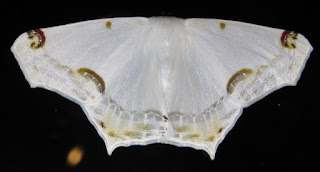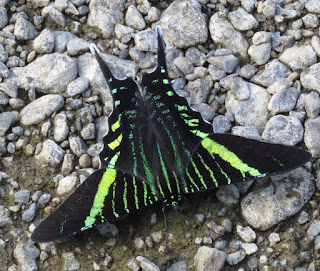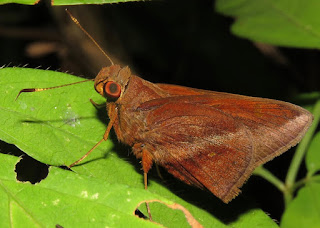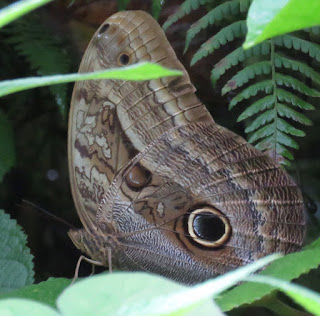I try to identify every butterfly and moth I can on my tours, usually requiring that I photograph them, but the birds sometimes get in the way. We may have seen several hundred species of butterflies fly by (and even thousands of moth at the hotel lights), but it’s not bad that I managed to tally 140 different types on my last spring tour in Costa Rica, many of which I only identified after comparing my photos to field guides. But it also includes some very general categories of moth, some of which I could identify only to family. A good example is this stunning moth in the huge family Geometridae at our lodge in the Cerro de la Muerte highlands.
This geometrid is distinctive enough that I found a species name: Sericoptera mahometeria, Amazon Silky White. There seem to be two very similar species in Costa Rica, this one with a pronounced spot halfway along the leading edge of the forewing.
This Mania sp., a swallowtail moth in the related family Sematuridae, could be one of a few very similar species.
This is Urania fulgens, Sunset Moth, also sometimes called a swallowtail moth, but it is in quite a different family, Uraniidae. Unlike Mania, this moth is diurnal, and our tour coincided with a big irruption throughout the country, though mostly on the Pacific side, and we saw them at sea level as well as over 10,000 feet at Cerro de la Muerte.
This day-flying cane-borer moth is Castniomera atymnius, family Castniidae, and is notable for having antennae that superficially look very much like those of a butterfly.
I’ve often turned to a Facebook group for moth enthusiasts to find names, and the moth whiz Kyhl Austin who frequents that group provided the name Truncaptera gigantea for this one. “Gigantea” is very appropriate for this member of Notodontidae; it was so large I assumed it was a sphinx moth and had no luck finding the genus among the complete collection of photos online.
Here’s an indisputable sphinx moth, Xylophanes ceratomioides.
Silkmoths in the family Saturniidae are among my favorites, but this enormous and gorgeous Rothschildia lebeau, spotted by another guest at the Arenal Observatory lodge, was over the top. It attracted the attention of all the tourists, not just the natural history buffs.
Butterfly species are fewer in number and therefore much easier to identify. Yet some genera are still very difficult, such as this Calephelis sp., in the metalmark family Riodinidae. It’s probably best determined to species by examining the male genitalia.
One of the more exciting butterflies on the tour for me was this quite plain looking Corrachia leucoplaga, Costa Rican Metalmark.
It’s unusual in being one of two New World butterflies in the otherwise Old World subfamily Nemeobiinae and is placed in its own tribe (there are very few monotypic tribes among the lepidoptera). There are very few photos of this little-known species published anywhere; when Philip deVries published his butterfly books for Costa Rica it was known only from a few specimens and he knew of very few sightings in the wild. Jim Brock and I were amazed when we discovered just two, in 2006 on our Costa Rica butterflies and birds tour. The larval hostplant (Myrsine sp. in the family Primulaceae) was discovered only 3 years after that. I have since seen one or two individuals on at least two other birding tours since then, but this year we were dealing with an outbreak along one stretch of the Providencia road. They were landing in the road, on our hats, and on our shirts. I estimate we saw more than 50 individuals in a short stretch of the road. Perhaps because they look and fly so much like moths, butterfly collectors had ignored them for so many years.
Many hairstreaks are difficult to identify, but I succeeding in getting names for two:
Oenomaus atena, Atena Hairstreak
Panthiades bathildis, Zebra-striped Hairstreak
This skipper was roosting at night at Bosque del Rio Tigre: Talides sergestus, Sergestus Ruby-eye.
I’ll finish with the large and variable family Nymphalidae, the brushfoots. This Pedaliodes triaria, Ochre-banded Satyr, was in the bamboo in the same area as the Corrachia above.
We had two owl butterflies on this tour; this Caligo illioneus, Dusky Owl-Butterfly, was near lake Arenal.
This Castilia ofella, White-dotted Crescent, was present for a few days in front of the main lodge building at Bosque del Rio Tigre.
We saw several heliconians, all looking for passionflowers on which to lay their eggs, but they don’t often land to permit identification. This one is Heliconius cydno, Cydno Longwing, at Sueño Azul.
We identified three crackers, named for the snapping sound territorial males make when chasing each other. All of them perch characteristically head-down on tree trunks.
Hamadryas aphinome, Red Cracker
Hamadryas guatemalena, Guatemalan Cracker























Great pix, thanks!
ReplyDelete